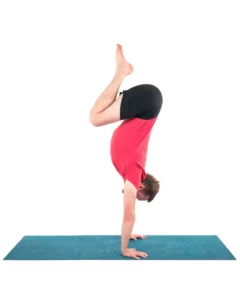5 Benefits of Yoga’s Frog Pose (Mandukasana)

Article At A Glance
One of yoga’s most accessible hip opening poses, Frog Pose (Mandukasana), offers 5 sometimes surprising benefits for beginning and advanced yoga students.
Frog Pose (Mandukasana), is a powerful hip-opening yoga posture that offers a wide range of benefits for the body and mind. This pose targets the core and offers a deep stretch to the hip flexors and inner thighs. Here are the basics:
- Sanskrit Name: Mandukasana
- English Name: Frog Pose
- Level: Intermediate
- Type: Hip Opener, Forward Bend
- Anatomy: Back, Hips. Knees
- Position: Prone
Read on to learn the top 5 benefits of Frog Pose and the benefits one gains from incorporating it into a regular asana practice.
Frog Pose Benefit # 1: Deep Hip Opening
One of the primary benefits of Mandukasana is its ability to stretch the hips deeply. By spreading the legs wide and sinking the hips toward the ground, this pose helps to release tension and tightness in the hip flexors, adductors, and glutes. This can be particularly beneficial for those who spend a lot of time sitting or have tightness in the hips from sports or other activities.
Keeping the hips level and grounded is important to get the most out of the pose. This can be achieved by firmly engaging the core muscles and pressing the thighs and feet into the ground.
Frog Pose Benefit # 2: Improved Digestion
Mandukasana is said to help stimulate the digestive organs by compressing the abdomen and massaging the internal organs. The posture involves spreading the legs wide and sinking the hips towards the ground, which creates a gentle compression in the lower abdomen. This compression can help to stimulate and improve the function of the digestive organs, including the stomach, intestines, and liver.
The deep hip opening aspect may also help relieve pelvic tension, which can be beneficial for those who experience digestive issues like bloating or constipation.
By practicing Frog Pose regularly and focusing on deep diaphragmatic breathing or belly breathing, you can enhance the benefits of this pose that promote healthy digestion. As always, it is important to listen to your body, practice mindfully, and seek guidance from a qualified yoga teacher if you have any concerns about your practice.
Frog Pose Benefit # 3: Increased Flexibility
Another benefit of Frog Pose is its ability to increase flexibility in the groin and inner thighs. Practicing Frog Pose regularly can help you improve your range of motion. It is important to note that you should hold this pose for several breaths and allow your body to gradually deepen and soften into the stretch to reduce the risk of injury and avoid overstretching the groin muscles. You may also use props such as blocks or blankets to support the hips and make the pose more accessible.
Frog Pose Benefit # 4: Stress Relief and Tension
Frog Pose is an excellent posture for relieving stress and tension in the body. By focusing on the breath and allowing the body to soften and release, you can create a sense of calm and relaxation in both the body and mind.
To enhance the stress-relieving benefits of Frog Pose, try practicing this posture in a quiet, dimly lit space and focusing on the sensation of the breath moving in and out of the body. You may also want to experiment with different variations of the pose, such as placing a bolster or blanket under the chest for a more restorative experience.
Frog Pose Benefit # 5: Improved Core Strength
By engaging the core muscles and lengthening the spine while you are in the pose, Mandukasana can also help improve posture and core strength. For this benefit, focus on lengthening the spine by reaching the tailbone back and the crown of the head forward. Keep the shoulders relaxed and away from the ears.
How to Practice Frog Pose

- Gather your props. You may want to have handy two folded blankets, a bolster, and two yoga blocks.
- Begin in Tabletop Pose (Bharmanasana) (see above image). Make sure your wrists are directly under your shoulders and your knees are under your hips. Your fingers should be spread wide and pressed firmly into the ground.
- Spread your knees apart as wide as you comfortably can, keeping your feet together. Place a folded blanket under your knees for additional support. Gently focus on lengthening the spine by reaching the tailbone back and the crown of the head forward.
- Slowly begin to shift your pelvis forward to lower your hips toward the ground, keeping your spine straight. You can rest your forearms on the ground or on two blocks for support. It can also be beneficial to rest your torso on a bolster.
- Hold the pose for 5 to 10 deep breaths. Keep your shoulders relaxed and away from your ears.
- To release the pose, slowly lift your hips back up and bring your knees back together. Return to Tabletop Pose.
In short, Frog Pose is a versatile and beneficial posture for the body and mind. However, be sure to go slow and don’t overdo it in the pose. Its deep hip opening action can be very soothing and beneficial, but it also can lead to injuries if you go overboard. Start gradually and build up slowly to increase the stretch over time as your body adjusts to the pose’s deep hip opening stretch.





